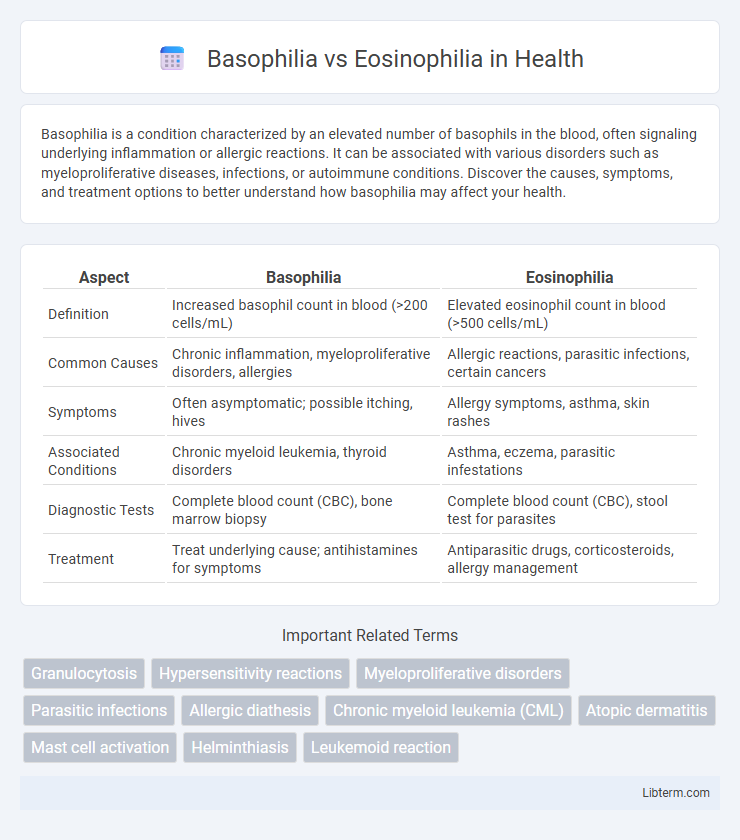Basophilia is a condition characterized by an elevated number of basophils in the blood, often signaling underlying inflammation or allergic reactions. It can be associated with various disorders such as myeloproliferative diseases, infections, or autoimmune conditions. Discover the causes, symptoms, and treatment options to better understand how basophilia may affect your health.
Table of Comparison
| Aspect | Basophilia | Eosinophilia |
|---|---|---|
| Definition | Increased basophil count in blood (>200 cells/mL) | Elevated eosinophil count in blood (>500 cells/mL) |
| Common Causes | Chronic inflammation, myeloproliferative disorders, allergies | Allergic reactions, parasitic infections, certain cancers |
| Symptoms | Often asymptomatic; possible itching, hives | Allergy symptoms, asthma, skin rashes |
| Associated Conditions | Chronic myeloid leukemia, thyroid disorders | Asthma, eczema, parasitic infestations |
| Diagnostic Tests | Complete blood count (CBC), bone marrow biopsy | Complete blood count (CBC), stool test for parasites |
| Treatment | Treat underlying cause; antihistamines for symptoms | Antiparasitic drugs, corticosteroids, allergy management |
Introduction to Basophilia and Eosinophilia
Basophilia and eosinophilia are hematologic conditions characterized by elevated levels of basophils and eosinophils, respectively, in the blood. Basophils, though rare, play a role in inflammatory and allergic responses, often increasing due to chronic myelogenous leukemia or hypersensitivity reactions. Eosinophils primarily respond to parasitic infections and allergic diseases, with eosinophilia commonly linked to asthma, atopic dermatitis, and certain parasitic infestations.
Definition and Distinction
Basophilia is characterized by an elevated basophil count, typically exceeding 200 cells/uL, often linked to allergic reactions, inflammation, or myeloproliferative disorders. Eosinophilia involves an increased eosinophil count, usually above 500 cells/uL, commonly associated with parasitic infections, allergic diseases, and certain malignancies. The key distinction lies in the type of white blood cell elevated--basophils in basophilia versus eosinophils in eosinophilia--each serving different roles in immune response and underlying pathologies.
Causes of Basophilia
Basophilia primarily results from chronic myeloproliferative disorders such as chronic myeloid leukemia, polycythemia vera, and essential thrombocythemia, as well as allergic reactions and hypothyroidism. In contrast, eosinophilia is commonly caused by parasitic infections, allergic diseases like asthma and eczema, and certain malignancies. Understanding these distinct etiologies aids in accurate diagnosis and targeted treatment of hematologic abnormalities.
Causes of Eosinophilia
Eosinophilia is primarily caused by allergic reactions, parasitic infections, and certain autoimmune diseases, distinguishing it from basophilia which is often linked to myeloproliferative disorders. Other causes of eosinophilia include drug hypersensitivity, some malignancies such as Hodgkin lymphoma, and chronic inflammatory conditions like eosinophilic esophagitis. Elevated eosinophil levels serve as key indicators for diagnosing these underlying conditions and tailoring targeted treatments.
Clinical Manifestations and Symptoms
Basophilia often presents with symptoms such as itching, hives, and swelling due to histamine release, commonly seen in allergic reactions and chronic myeloproliferative disorders. Eosinophilia manifests with respiratory issues like wheezing and cough, skin rashes, and gastrointestinal discomfort, frequently linked to parasitic infections, asthma, and allergic conditions. While basophilia typically causes symptoms related to inflammation and hypersensitivity, eosinophilia is more associated with tissue damage and organ dysfunction from eosinophil infiltration.
Diagnostic Approaches
Basophilia and eosinophilia are diagnosed primarily through a complete blood count (CBC) with differential, which quantifies basophil and eosinophil levels respectively. Bone marrow biopsy and flow cytometry may be employed to identify underlying hematologic disorders causing persistent or unexplained elevations. Specific diagnostic tests include allergy panels and parasitic infection screenings for eosinophilia, whereas basophilia may require evaluation for myeloproliferative neoplasms via genetic testing such as BCR-ABL1 and JAK2 mutations.
Laboratory Findings and Differences
Basophilia is characterized by an elevated basophil count above 200 cells/mL, often linked to chronic myeloproliferative disorders, whereas eosinophilia shows eosinophils exceeding 500 cells/mL commonly due to allergic reactions or parasitic infections. Laboratory findings in basophilia reveal increased basophils with possible elevated histamine and tryptase levels, while eosinophilia presents with high eosinophil counts paired with elevated serum IgE or eosinophil cationic protein. Differentiating these conditions relies on peripheral blood smear, bone marrow biopsy, and specific markers such as Philadelphia chromosome testing for basophilia-related myeloproliferative neoplasms.
Related Disorders and Conditions
Basophilia is commonly associated with myeloproliferative disorders such as chronic myeloid leukemia and polycythemia vera, often indicating allergic reactions or chronic inflammation. Eosinophilia is frequently linked to parasitic infections, allergic diseases including asthma and atopic dermatitis, as well as autoimmune disorders like eosinophilic esophagitis and hypereosinophilic syndrome. Both conditions require differential diagnosis since they reflect diverse pathophysiological processes and may coexist with other hematologic abnormalities.
Treatment and Management Strategies
Treatment and management strategies for basophilia primarily focus on addressing underlying conditions such as chronic myelogenous leukemia or allergic reactions, often involving antihistamines, corticosteroids, or targeted therapies like tyrosine kinase inhibitors. Eosinophilia management is directed at controlling causes like parasitic infections, allergic disorders, or hypereosinophilic syndrome, with treatment options including corticosteroids, anti-parasitic drugs, and monoclonal antibodies such as mepolizumab. Both conditions require regular monitoring of blood cell counts and tailored therapies based on the severity and etiology to prevent organ damage and complications.
Prognosis and Clinical Implications
Basophilia often indicates chronic inflammatory conditions, myeloproliferative disorders, or allergic reactions, with prognosis varying based on underlying causes, sometimes signaling poor outcomes in hematologic malignancies. Eosinophilia typically suggests parasitic infections, allergic diseases, or certain malignancies, with clinical implications including tissue damage and organ dysfunction if prolonged or severe. Accurate identification of the cause of basophilia or eosinophilia is crucial for targeted treatment and improved patient prognosis.
Basophilia Infographic

 libterm.com
libterm.com